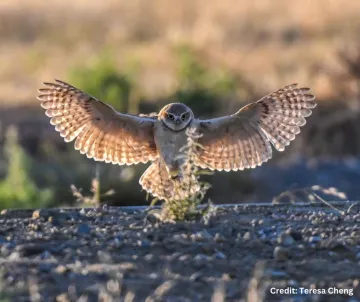September 27, 2024

Sadly, the Burrowing Owl population of the Bay area has dwindled close to extirpation (local extinction). The California Fish & Game Commission will hold a public hearing on October 10th to determine whether listing western burrowing owl populations in California as threatened or endangered under the California Endangered Species Act (CESA) may be warranted.
You can help the burrowing owls by:
- Sending an email to the California Fish and Wildlife Commission before 5:00pm before October 4 (fgc@fgc.ca.gov)
- Attending the meeting remotely on Thursday, October 10th at 8:30 AM (Item 14 on the agenda, will be heard soon after the start of the meeting) (instructions to join online)
- Attending the meeting in Sacramento in person (Natural Resources Headquarters Building, 715 P Street, Sacramento, in the Auditorium).
Here are talking points you can use in your comments:
- Tell the Commission about any experiences or connections you have with burrowing owls and why you care about them.
- Urge the Commission to designate five imperiled burrowing owl populations (San Francisco Bay Area, Central-Western California, Southwestern California, Central Valley, and Southern Desert Range) as candidate species under the California Endangered Species Act.
- Candidate status for these declining owl populations will allow the CA Department of Fish & Wildlife to conduct a full status review of the species and make an informed recommendation to the Commission about whether to designate imperiled populations as threatened or endangered species.
- Burrowing owls were once widespread throughout California but have suffered significant habitat loss due to conversion of grasslands to sprawl development and eradication of ground squirrels.
- Burrowing owls have been eliminated as a breeding species or are near extirpation in nearly one-third of their former range in California.
- Statewide surveys showed a 60% decline in California’s burrowing owl colonies from the 1980s to the early 1990s, and a further 11% decline in breeding pairs by 2007. Loss of breeding colonies has accelerated since 2015.
- Outside of the Imperial Valley, only 2,500 or fewer breeding pairs of burrowing owls remain in the state.
- We are on a trajectory to lose breeding burrowing owl populations entirely from the San Francisco Bay Area, Central Coast, and Southwestern California; breeding owls are also rapidly declining in the Central Valley and southern desert regions.
- The relatively large burrowing owl population in the Imperial Valley does not serve as a dispersal source to augment isolated or depleted owl populations elsewhere in the state. Extensive data from banded burrowing owls shows very little evidence of movements of resident owls between regional populations in California.
- Since they can live in the margins of infrastructure and agriculture, burrowing owls are often considered to be adaptable. But they have very specific habitat requirements, including burrows excavated by ground squirrels; grasslands or arid environments with short, sparse vegetation; adequate foraging habitat with abundant and available prey; and opportunities for wintering and dispersal.
- Large burrowing owl colonies on private lands are not being protected, and habitat requirements are not being met even on many public lands, which is why state listing is needed.